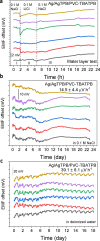A Solid-Contact Reference Electrode Based on Silver/Silver Organic Insoluble Salt for Potentiometric Ion Sensing
- PMID: 36785773
- PMCID: PMC9886000
- DOI: 10.1021/acsmeasuresciau.2c00036
A Solid-Contact Reference Electrode Based on Silver/Silver Organic Insoluble Salt for Potentiometric Ion Sensing
Abstract
Solid-contact ion-selective electrodes are a type of ion measurement devices that have been focused in wearable biotechnology based on the features of miniaturization and integration. However, the solid-contact reference electrodes (SC-REs) remain relatively less focused compared with numerous working (or indicator) electrodes. Most SC-REs in wearable sensors rely on Ag/AgCl reference electrodes with solid electrolytes, for example, the hydrophilic electrolyte salts in polymer matrix, but face the risk of electrolyte leakage. Herein, we report a type of SC-REs based on the silver/silver tetraphenylborate (Ag/AgTPB) organic insoluble electrode. The SC-RE consists of a Ag substrate, a solid contact (AgTPB), and a plasticized poly(vinyl chloride) (PVC) membrane containing the hydrophobic organic salt of tetrabutylammonium tetraphenylborate (TBATPB). The potentiometric measurements demonstrated that the SC-RE of Ag/AgTPB/PVC-TBATPB showed a reproducible standard potential in various electrolytes and disclosed high long-term stability. This SC-RE was further fabricated on a flexible substrate and integrated into all-solid-state wearable potentiometric ion sensor for sweat Cl- monitoring.
© 2022 The Authors. Published by American Chemical Society.
Conflict of interest statement
The authors declare no competing financial interest.
Figures





References
-
- Hu J.; Stein A.; Bühlmann P. Rational design of all-solid-state ion-selective electrodes and reference electrodes. TrAC, Trends Anal. Chem. 2016, 76, 102–114. 10.1016/j.trac.2015.11.004. - DOI
-
- Zdrachek E.; Bakker E. Potentiometric Sensing. Anal. Chem. 2021, 93, 72–102. - PubMed
-
- Ding J.; Qin W. Recent advances in potentiometric biosensors. TrAC, Trends Anal. Chem. 2020, 124, 11580310.1016/j.trac.2019.115803. - DOI
LinkOut - more resources
Full Text Sources
